Intro
The Bread Baker’s Apprentice challenge (BBA Challenge) is a challenge to bake all of the breads from the book Bread Baker’s Apprentice, alphabetically from Anadama through whole-wheat.
There are a total of 46 recipes, covering a large diversity in bread types. I started the challenge on September 4th 2020, and completed it on December 30th 2020, so was making a bread approximately once every 4 days.
I think I learned a lot simply by making bread over and over and over again. So much of baking bread is feeling and intuition, and just knowing from the feel of the dough whether to knead more, or let it proof for longer. I definitely felt a shift in my baking by the latter half of the book. To begin with I was essentially following the recipes rote, but after a while I started making game-time adjustments (“hmm, it’s a bit cold and this hasn’t proofed enough, I’ll give it another 30 minutes”, “five minutes wasn’t enough kneading here, the dough needs more”).
Overall I’m absolutely glad that I spent a few months baking bread multiple times a week. I’m ready for a break for a little while now, but am very excited about my newfound skill and can’t wait to apply it to all manner of other bready goods.
Breads
#46: Roasted Onion and Asiago Miche (pp. 310-313)



Great way to finish out the book. This is one of my favorite breads from the whole thing. The combination of the dough containing a lot of fat (cheese and oil) with the high cooking temperature led to a crispy outside, just covered in cheese. 10/10 would make again.
#45: Potato, Cheddar, and Chive Torpedoes (pp. 307-309)
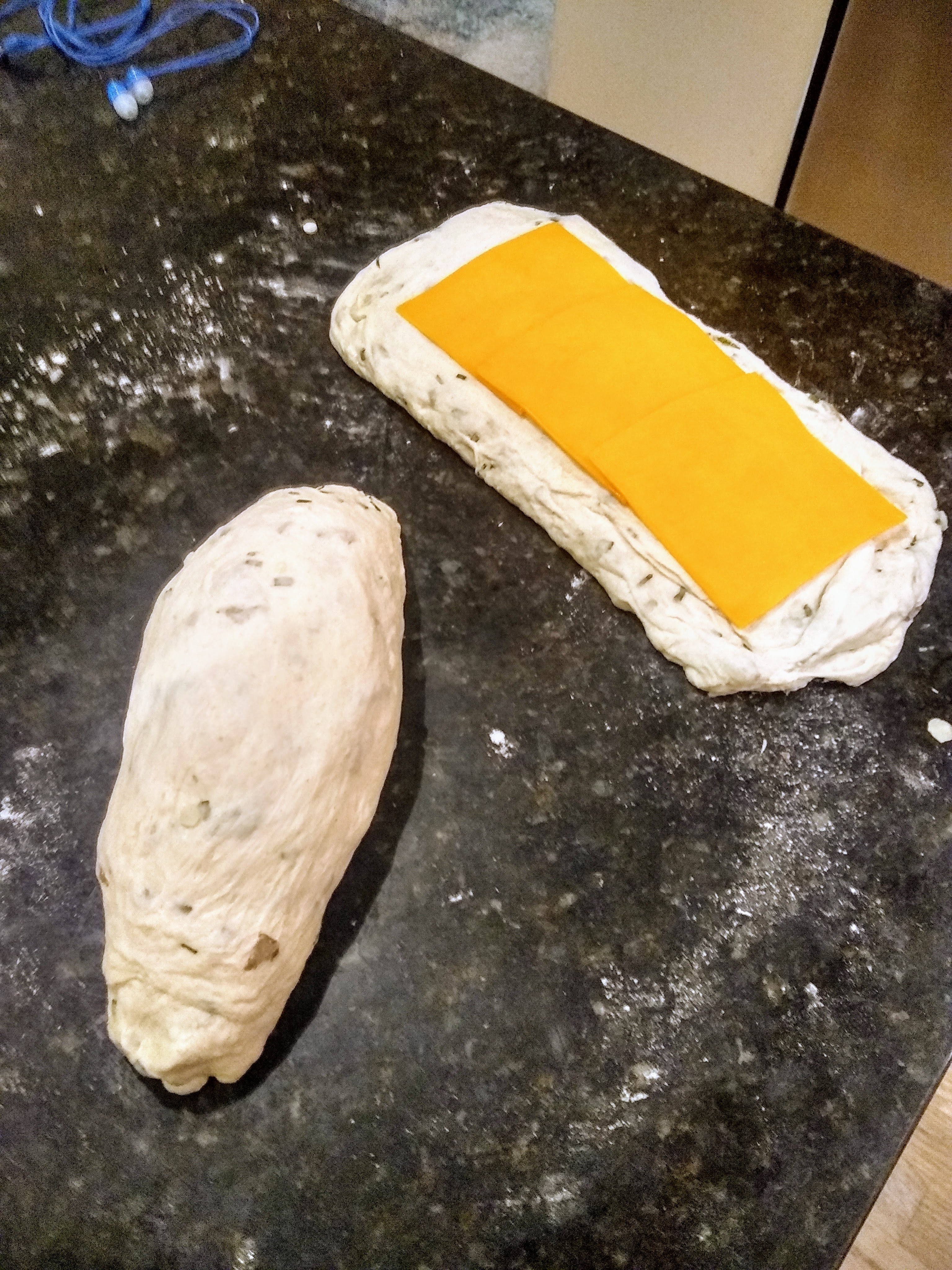


I knew I was going to love this one after just reading the description. The previous recipes that included potato ended up super airy and light, this one was no exception. Has a spiral of cheese through the whole roll, which you slash open to make look good when they cook. I love this.
#44: Beyond Ultimate Cinnamon and Sticky Buns (pp. 297-301)



This recipe works for cinnamon buns and also “sticky buns”, which are not a thing I ever heard of before, but are essentially cinnamon buns cooked on a bed of caramel, then flipped upside down so the caramel soaks through them. Just going to say: Very, very, very tasty and also absolutely not something I should be near ever again because that was a lot of calories.
#43: Sprouted Whole Wheat Onion and Poppy Seed Bialys (pp. 294-296)


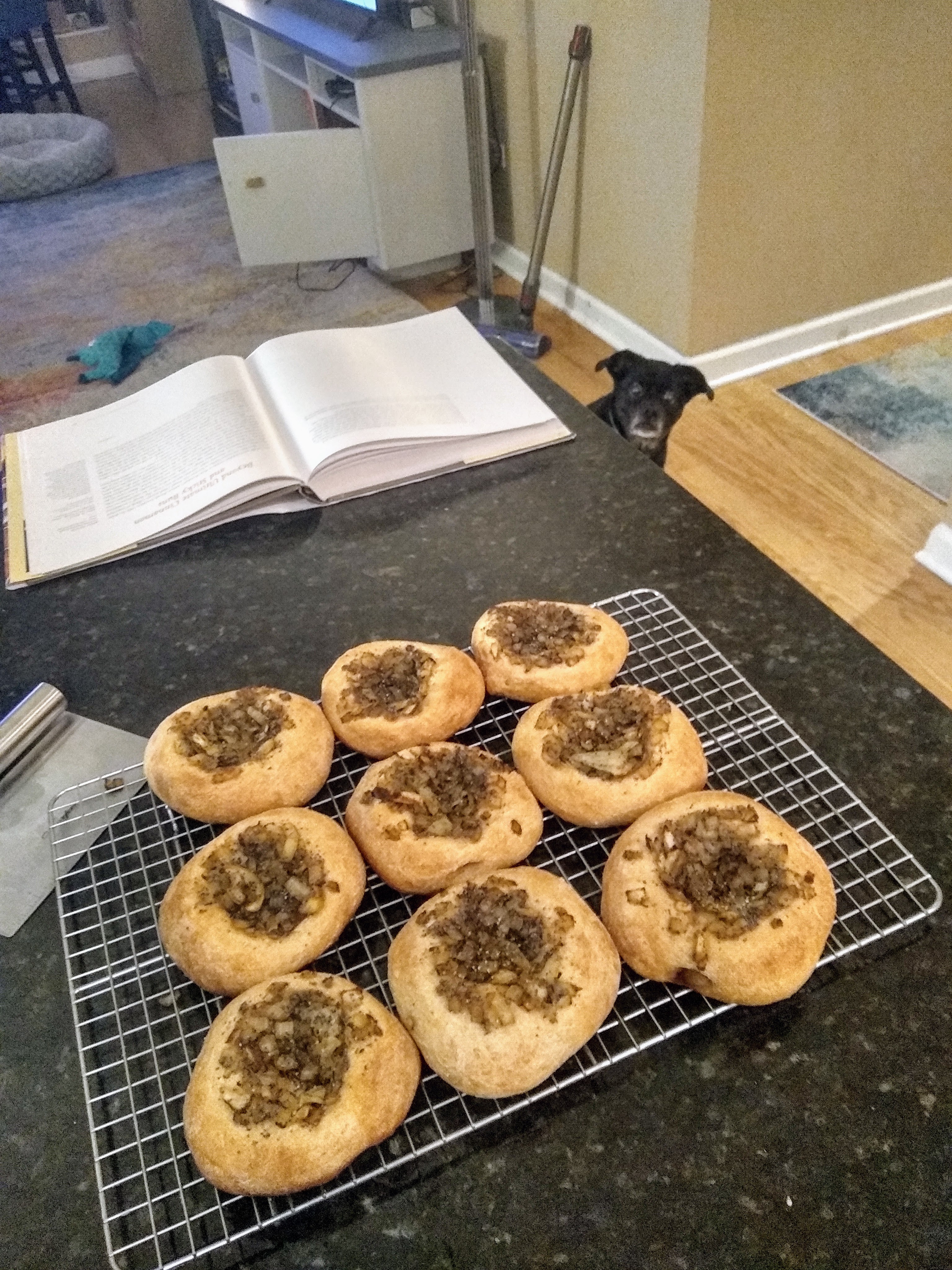
Yet another one where I have no idea what the bread should taste like since I have never seen a bialy before, but the result turned out pretty great! The dough has a really lovely sweet taste despite having no sugar in it (that’s probably the sprouted wheat flour), and the poppy seed and onion filling adds a great taste and texture to the whole thing.
#42: Sprouted Wheat and Brown Rice Bread (pp. 291-293)



Struggled a bit with this one. Still really not used to sprouted flour, and I didn’t get much of a rise here. It feels like filling the bread with brown rice just weighed everything down. I don’t know, no science behind that, but I ended up with a fairly dense crumb. Bread had a nice taste to it, though!
#41: Whole-Wheat Bread (pp. 288-290)



I really don’t have too many thoughts about this. It’s nice sandwich bread.
#40: White Breads (pp. 284-287)



One interesting thing about this book being arranged alphabetically is that the real basics (white bread and whole wheat bread) sort near the end of the alphabet. At this point, knocking out a direct yeasted, medium hydration, slightly enriched white dough felt like second nature and at times I wasn’t doing much more than skimming the recipe.
It was nice, too!
#39: Vienna Bread (pp. 280-283)
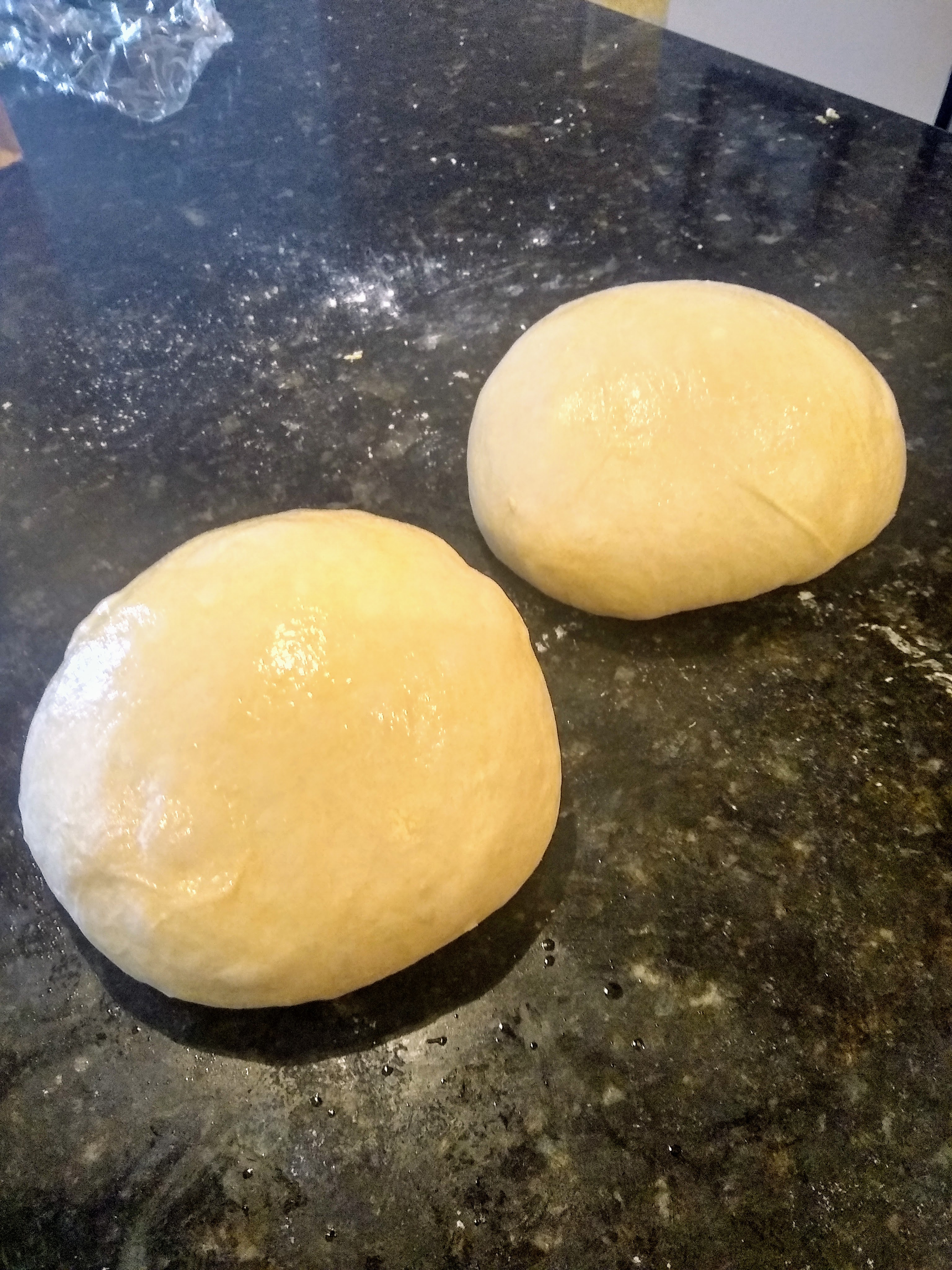
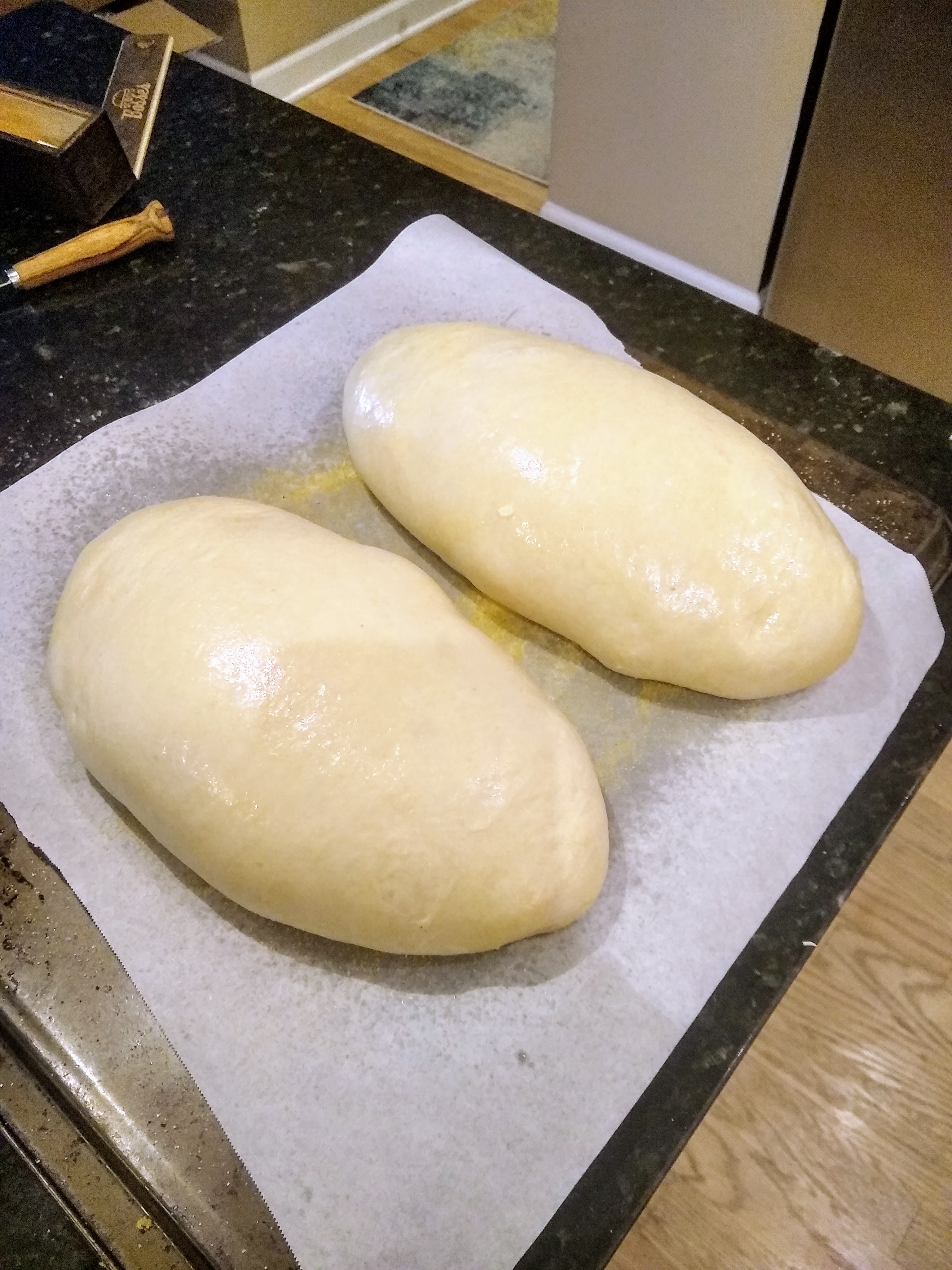

Not really too much to say about this one. It was a nice, pillowy white bread. I would be hard pushed to differentiate it from the Italian bread, but it did make nice sandwiches.
#38: Tuscan Bread (pp. 277-279)



I didn’t expect much from this. It’s bread with no salt, which typically tastes very “flat”. The new technique is to cook flour in boiling water to make a paste, which brings out the sugars in the flour in a different way to most baking. My overall impression was that this bread is sweet, like it had sugar in it. That said, it did have the “flat” taste that I associate with a lack of salt. I think my big takeaway here is the use of the boiled flour paste as a way of expressing extra sweetness in a loaf.
#37: Swedish Rye (Limpa) (pp. 274-276)



There are a surprising number of breads in this book that have that Christmassy/medicinal taste. I remain not a big fan of that flavor combo, and this bread was no exception. At least it made my house smell nice when I boiled molasses, orange extract, aniseed, cardamom and fennel. I also think I must have made a mistake somewhere, the dough was surprisingly stiff and even after I added extra water it was very hard to work.
#36: Stollen (pp. 268-273)



It’s another Christmas bread, and so tastes a lot like the Greek celebration bread and the pannetone. Little more to add on top of that, but it was fairly nice, and the heavy dusting of powdered sugar certainly added something.
#35: Sunflower Seed Rye (pp. 264-267)



I ended up being surprised how much I liked this one. I haven’t really enjoyed too many of the recipes that use coarse and/or rye flours, but after making this one it’s a nice rustic looking couronne which has a pleasant nutty taste. Not my usual preference but actually very nice!
#34: Pumpernickel Bread (pp. 260-263)



This probably counts as my first BBA challenge fail. I’m not a giant fan of the taste, and I took a bit of a risk by baking this sourdough in loaf pans. The crumb is much denser at the bottom of the loaf than the top, which I’m used to seeing when I don’t get the baking stone hot enough for sourdough. I think that maybe my opinion would have been different had I cooked this at high temperature and humidity, but what came out this time was a dense, stodgy block.
#33: Poilâne-Style Miche (pp. 256-259)


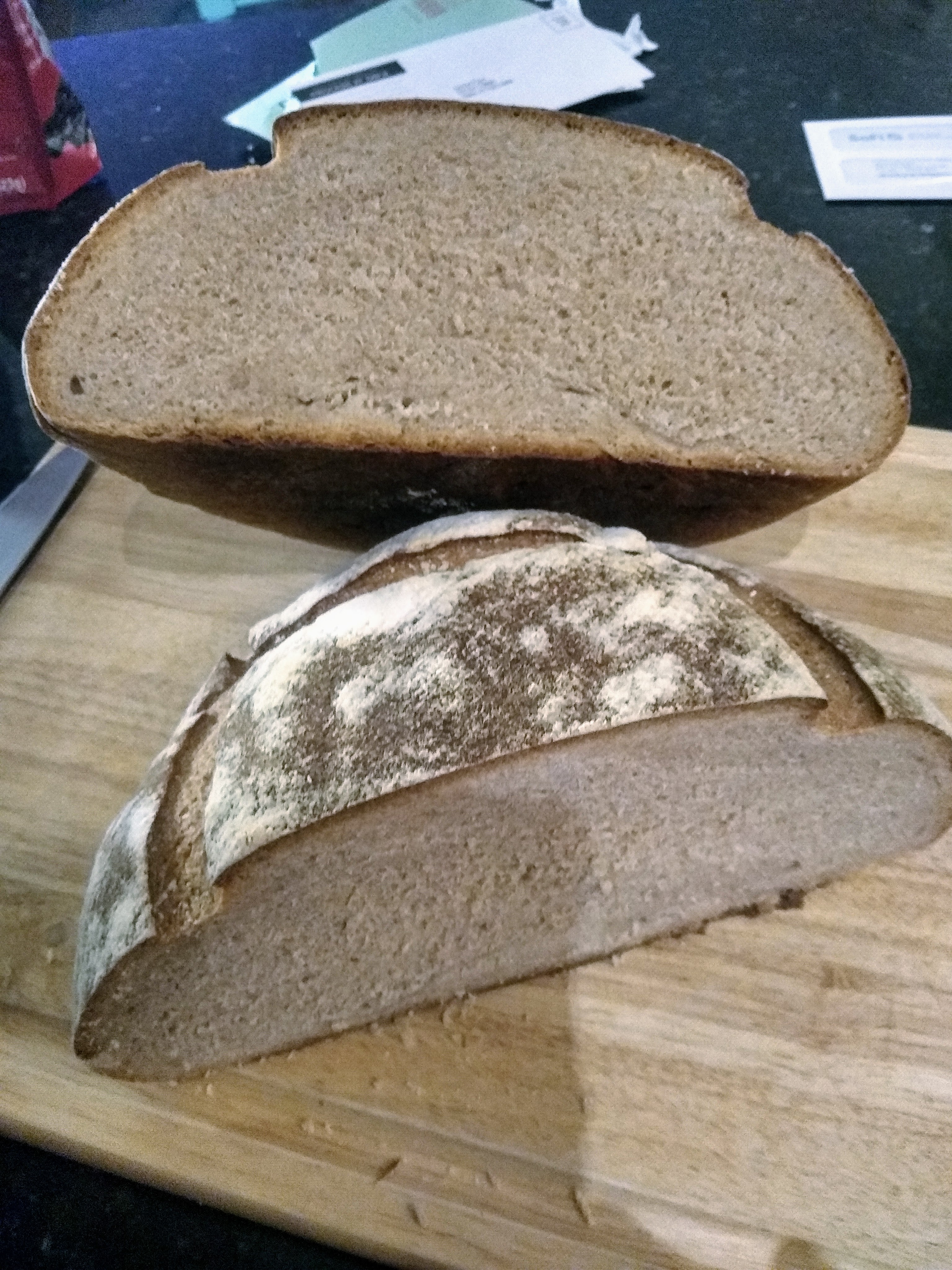
I was looking forward to this one if for no reason other than to make a 4 lbs loaf of bread, and I certainly succeeded at that. It looks the part, and although the crumb is a bit tight has a solid sourdough taste.
#32: 100% Sourdough Rye Bread (pp. 253-255)



THis bread was honestly the least fun I had doing this challenge, and I don’t think I ever got it to work. First time through, I overmixed it and it had the texture of play doh, and was grey. Second time through I gome something marginally better, but it barely rose. No idea what I did wrong, but 100% frustrated at myself for this one.
#31: New York Deli Rye (pp. 249-252)
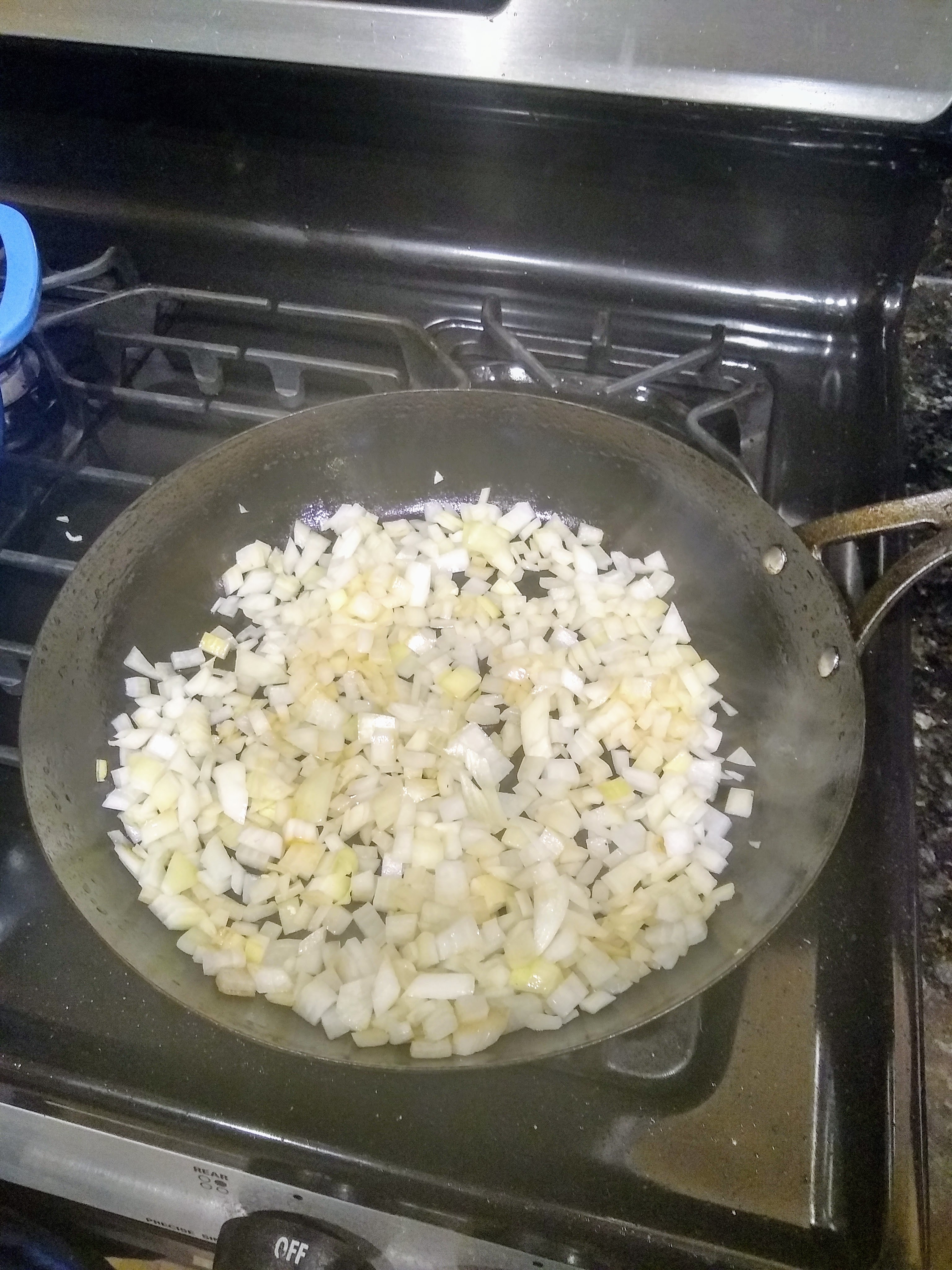


Another excellent bread. I came to realize during baking this that I’m one of those people who don’t really know the difference in taste between carraway seeds and rye flour since I have always tasted them together. Next time through with a rye bread I’m definitely goin no-carraway. Anyway, the onions cooking in this bread gave it a delicious, well… oniony aroma and it tastes amazing.
#30: Basic Sourdough Bread (pp. 245-248)
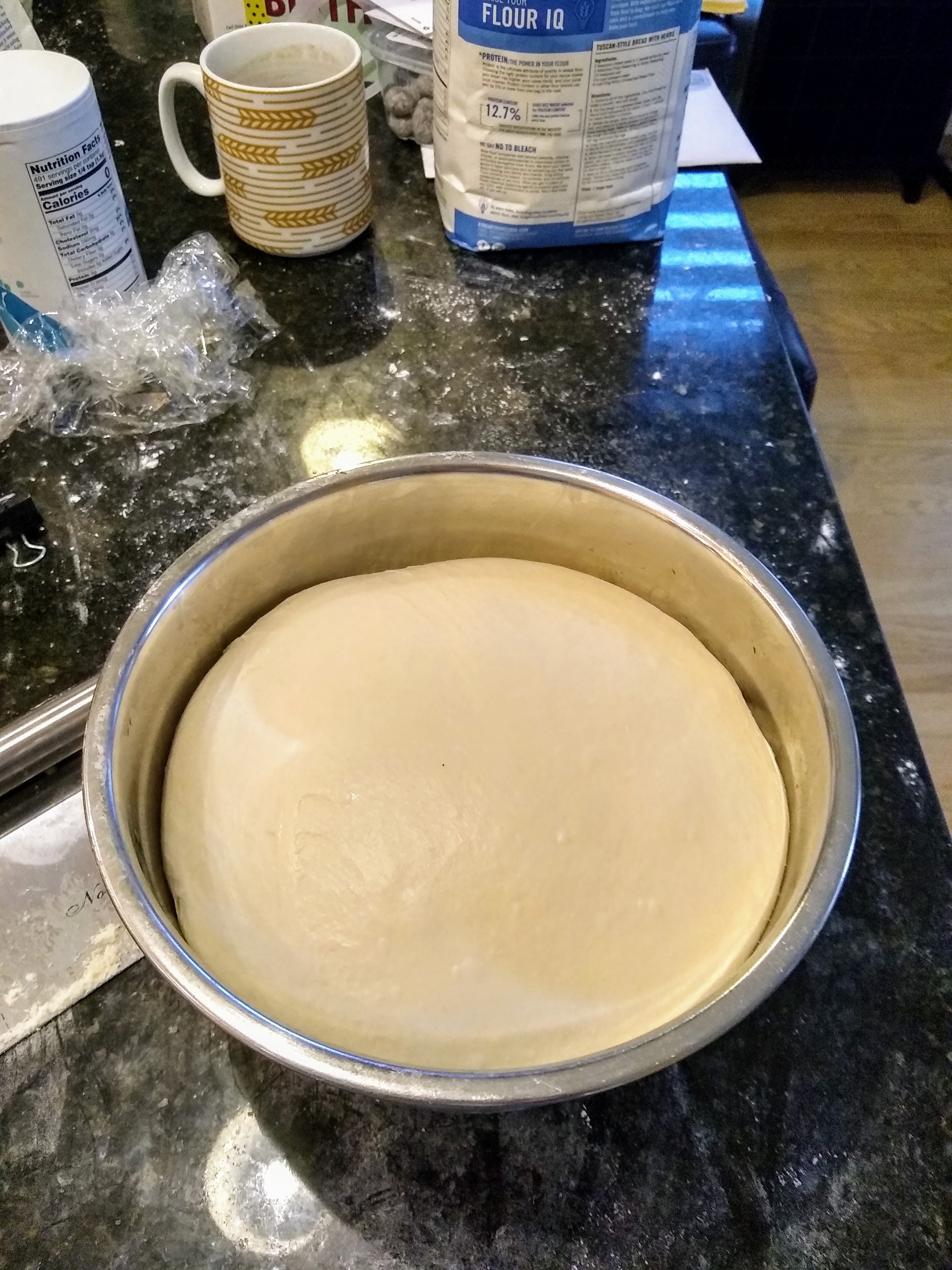

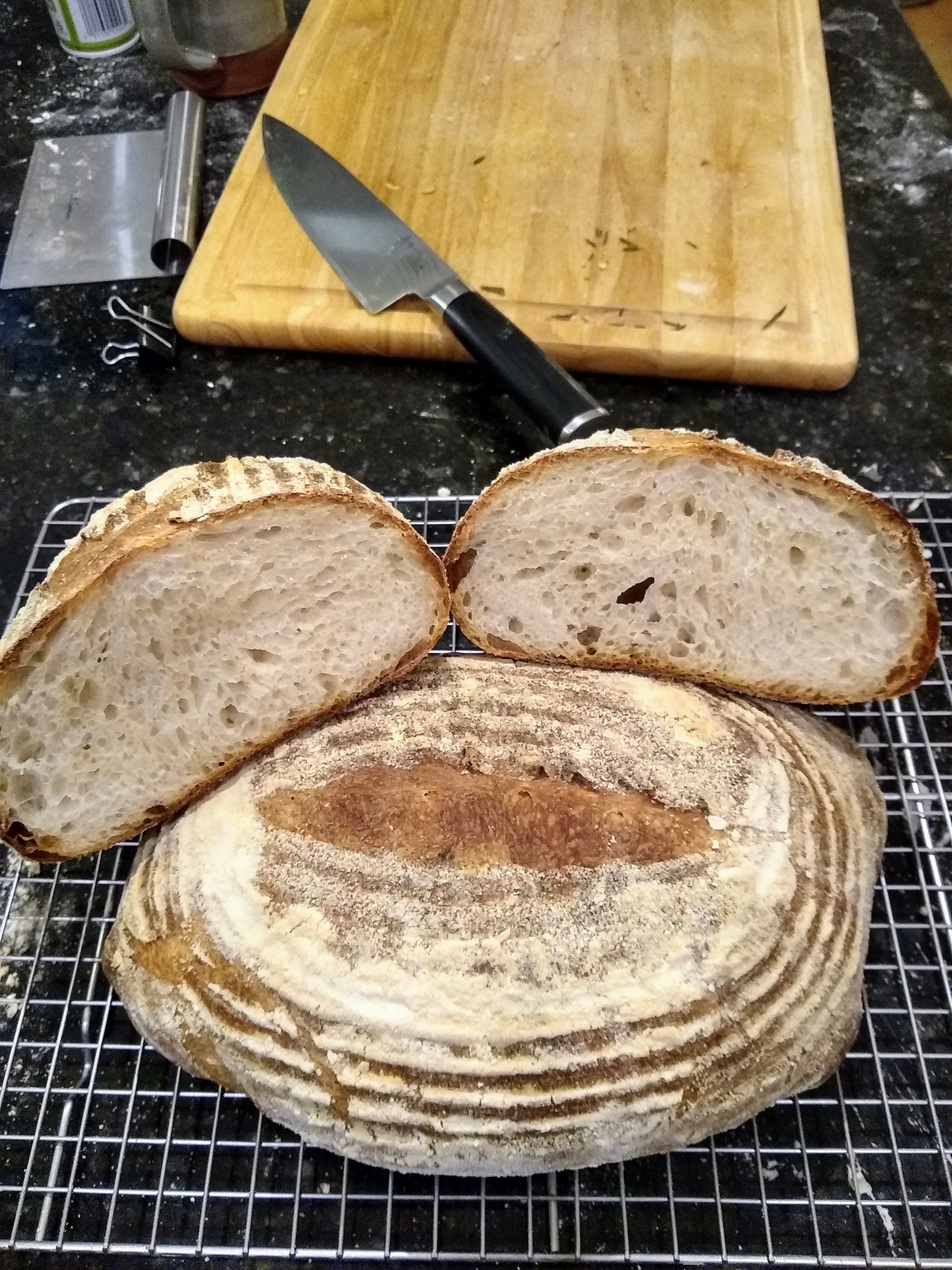
I started out baking by making the sourdough from the Tartine book over and over again until I got a feel for it. I was interested to see how this recipe differed, and it certainly did differ! This one is knead-heavy before doing stretch-and-folds, there was no autolyse step, and instead of cooking in a dutch oven, you make your oven into a hearth oven.
Overall it worked… fine. I didn’t get the large oven spring I typically got from the Tartine bread, but it was sourdough, and the crumb looked just fine. Overall I prefer the Tartine method, no idea how much of the difference is simply using a dutch oven to keep moisture around the bread and how much of the difference is the many small differences between the recipes
#29: Pugliese (pp.233-237)



This was the most delightful surprise of the book so far. I love this bread a lot. Really big, airy crumb, dark but soft crust. 10/10.
#28: Potato Rosemary Bread (pp. 229-232)



This bread was truly amazing: Rosemary, olive oil, roasted garlic, mashed potatoes. It was pillowy soft and tested delicious. I 100% want to make this one again.
#27: Portuguese Sweet Bread (pp. 226-228)



Not 100% sure what to think of this one. I can’t call the bread “pillowy” as described in the recipe, the outer crust is actually shiny and crunchy, and the inside is sweet. It’s almost like a pound cake. Not really one for me, although it does look very pretty.
#26: Poolish Baguettes (pp. 223-225)



Nice crusty baguettes. I got a bit lazy with the shaping so they puffed up and tore a little bit. This was the first time I followed some advice in a book that said when scoring the baguettes, “don’t be too careful” and found that three very rapid slashes with the razor actually worked a lot better than the careful picking I was doing up until now.
#25: Pizza Napoletano (pp. 217-222)



Exciting one to start, I have never made pizza before. I ended up being 50% happy with the result. I didn’t get the big blistered bubbles I was hoping for, but it was a decent pizza with a good crunch to the crust. My main lesson here was really that I should minimize the number of toppings to let the crust shine through.
#24: Panettone (pp. 211-216)
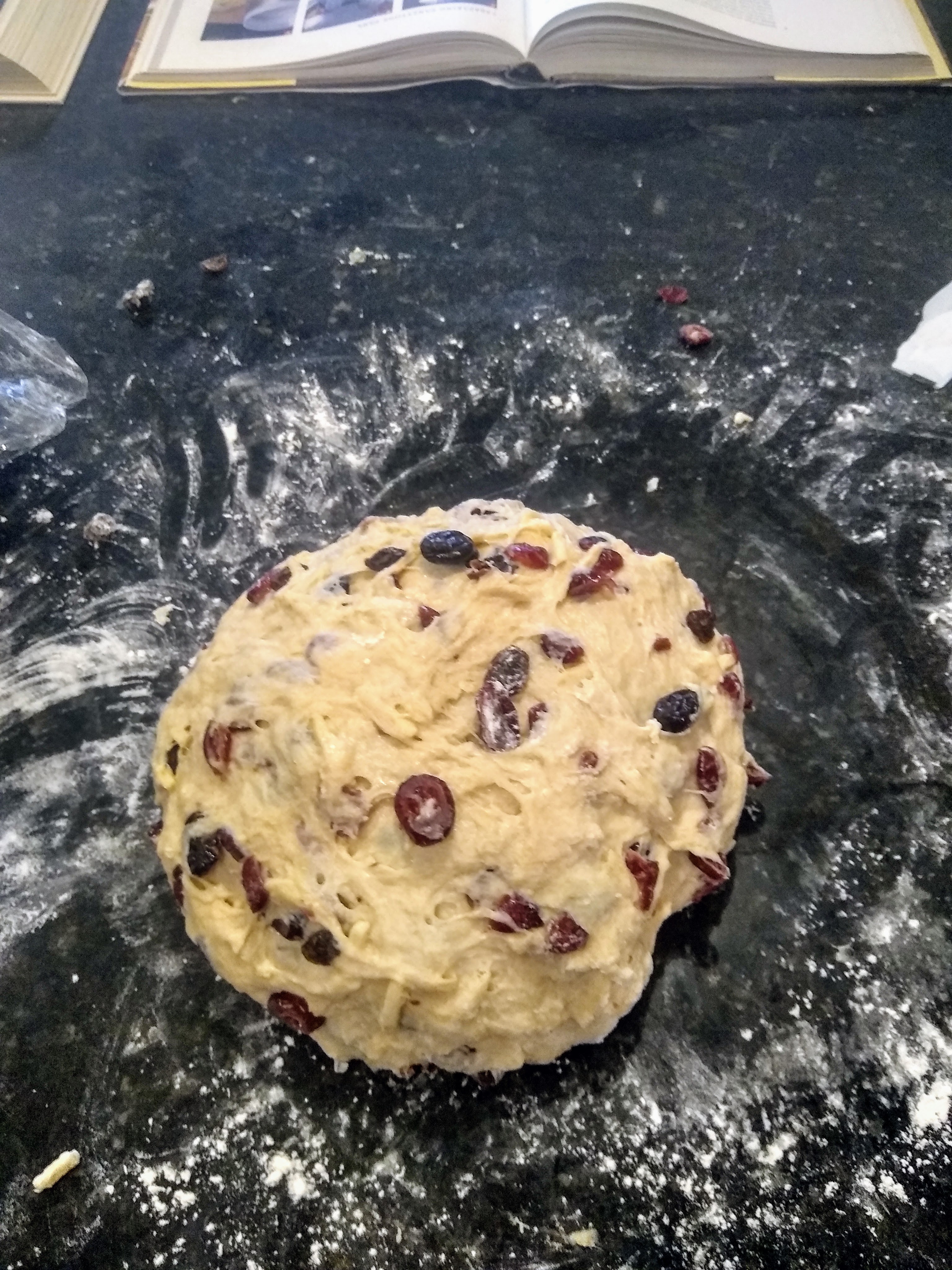
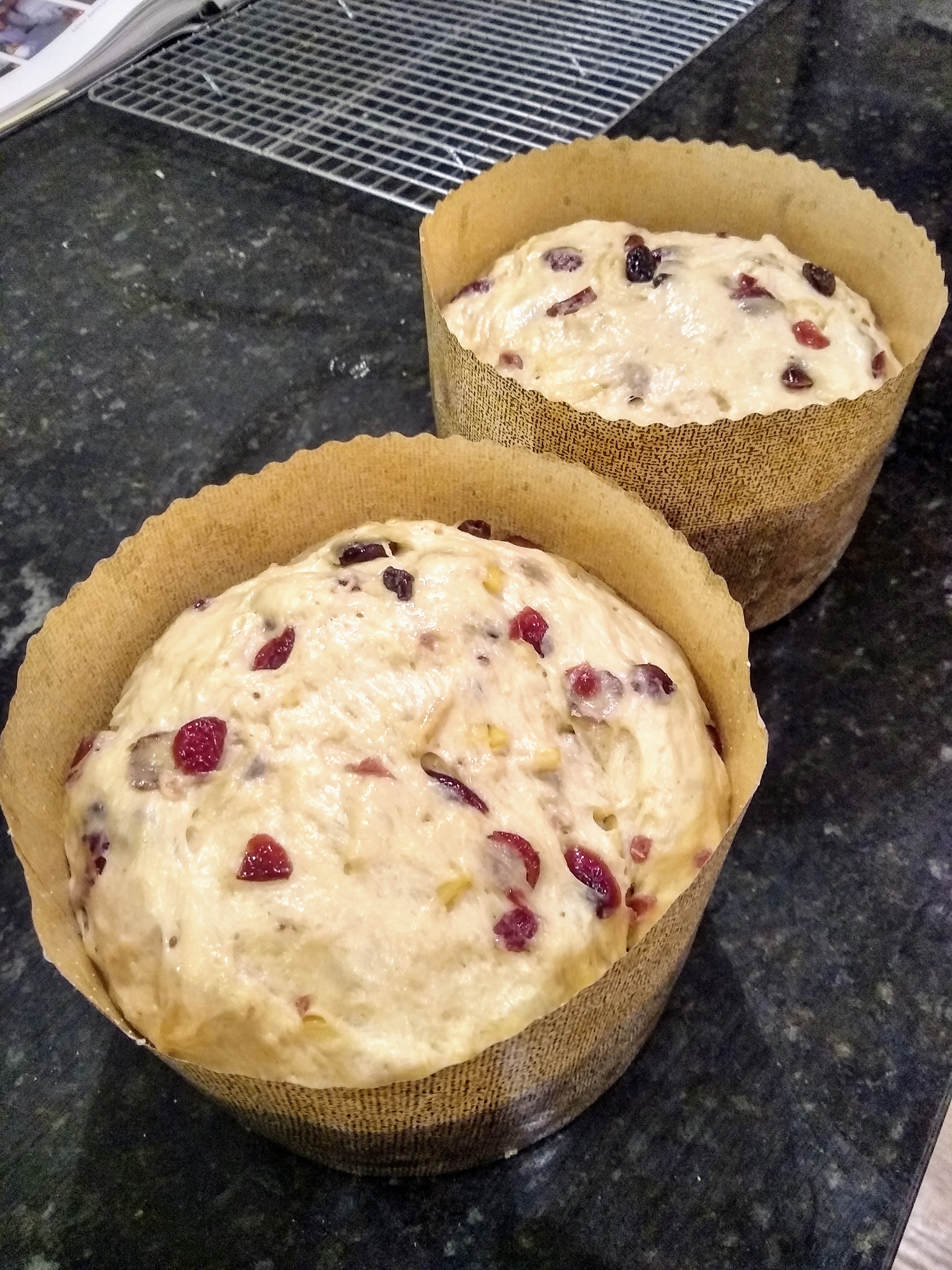

Not a giant fan of this. I bought Fiore di Sicilia extract to go in this, which was a wildly overpowering floral flavor. The bread itself is… fine, I guess. Lots of Christmassy flavors that I’m just not a big fan of. Not one that I’ll make again.
#23: Pane Siciliano (pp. 207-210)


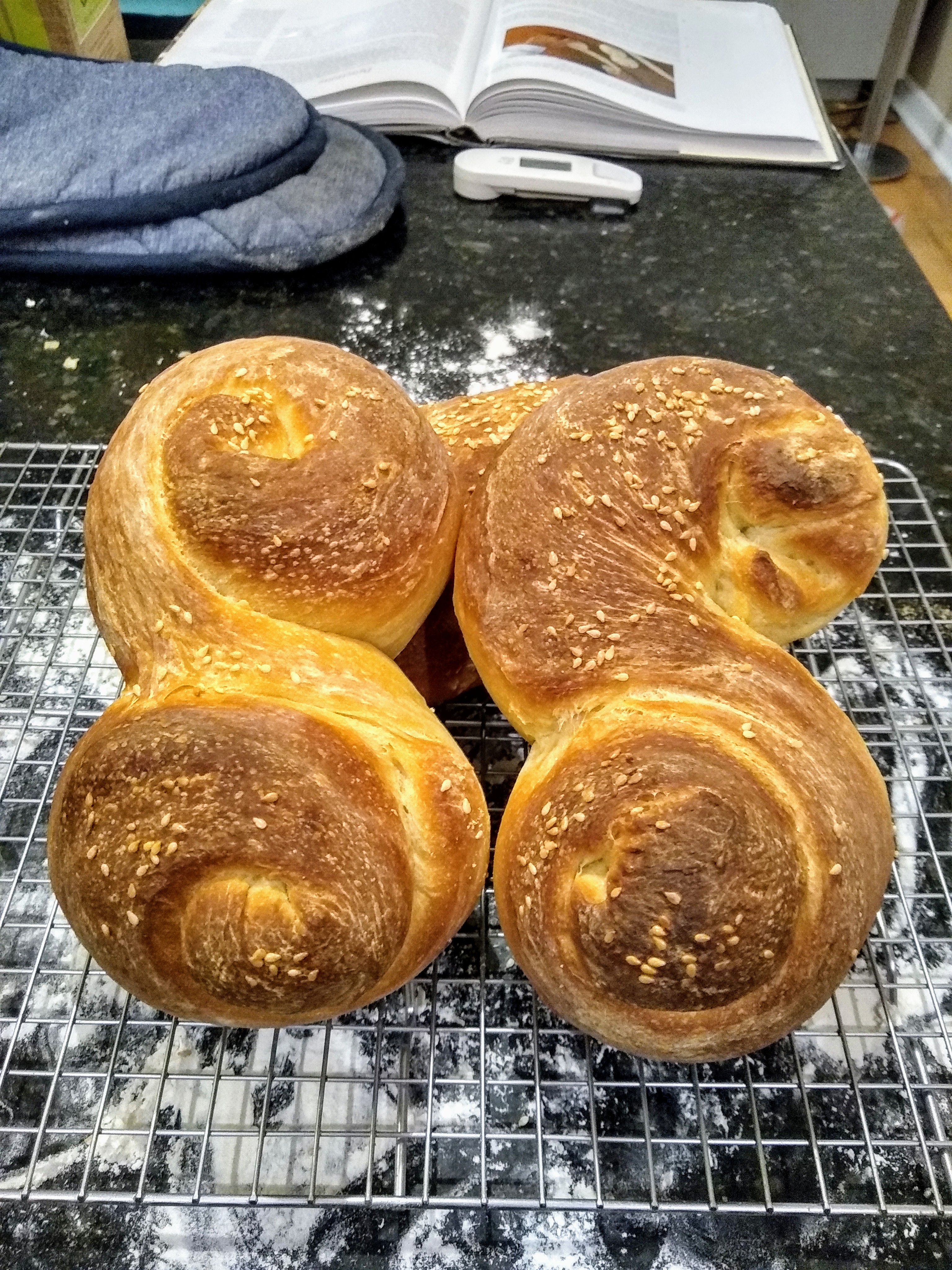
Wasn’t expecting much from this one, it’s a curled up baguette. That said, this maybe turned out to be one of the best breads I have baked! The sesame seeds added a great toasty taste, and the loaf itself was big, airy and tasty.
#22: Pain de Campagne (pp. 203-206)



OK this was fun so I made an extra sized batch (enough for four loaves of bread). It is pointed out that this is a good dough to test out shaping of bread, and so I decided to try out a few different shapes. I didn’t do a great job with my scissor cuts, but the others looked beautiful. The breead itself was a satisfying white bread.
#21: Pain à l’Ancienne (pp. 198-202)



I have been looking forward to this one for a while. Lean dough, with an interesting method where you use ice cold water when mixing to delay the yeast from waking up, and do a super long proof in the fridge.
Ended up with 6 crusty, rustic looking baguettes. Really am incredibly happy with this one.
#20: Multigrain Bread Extraordinaire (pp. 195-197)
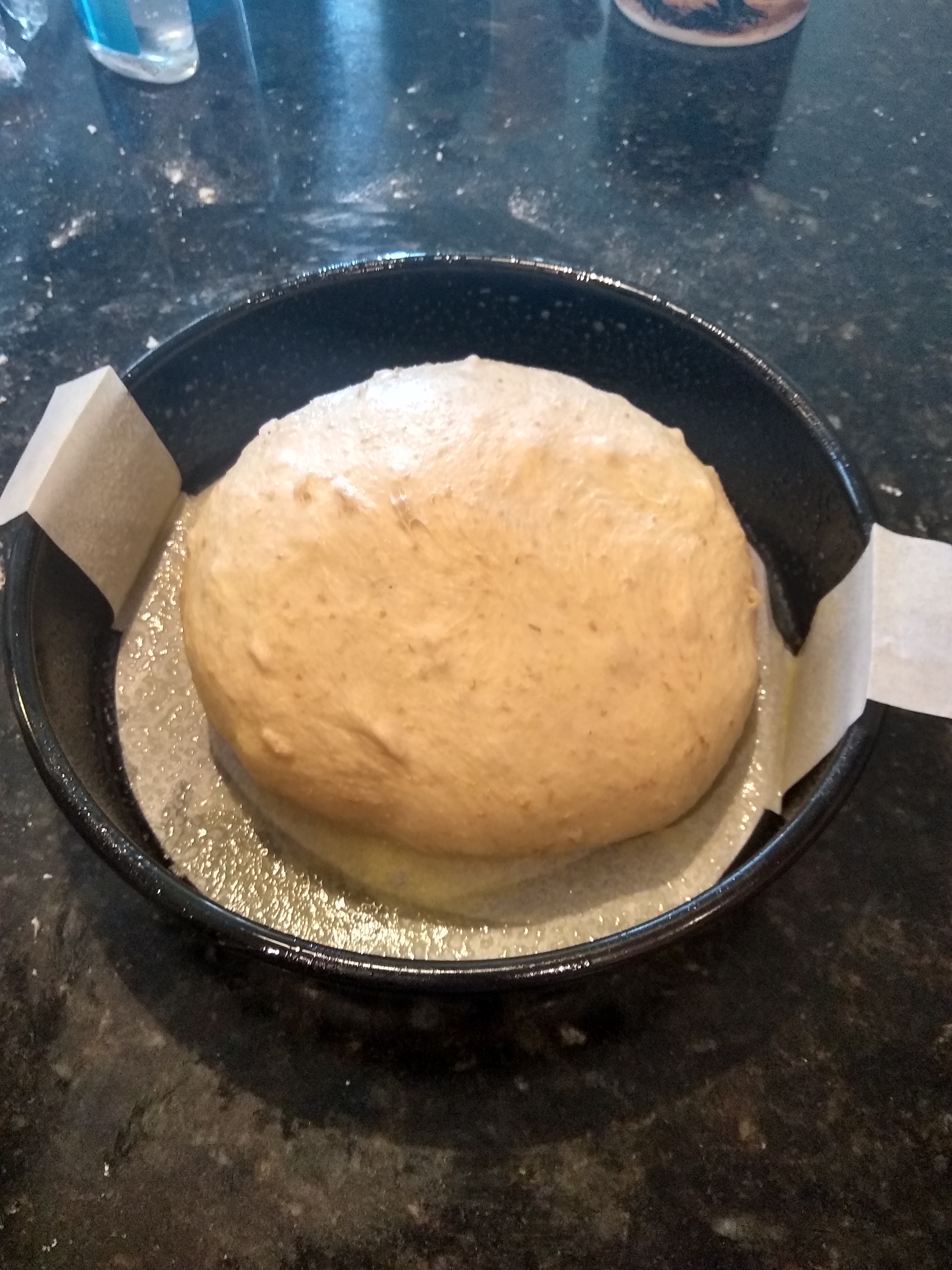


I have never been the biggest fan of multigrain bread, but here we are. It’s a white bread with brown rice, rolled oats, bran and cornmeal. Tasted a lot like multigrain bread, and as promised it made great toast. As with so many of these recipes, I’m mainly happy that I was able to make multigrain bread, but likely won’t make it again.
#19: Marbled Rye Bread (pp. 191-194)

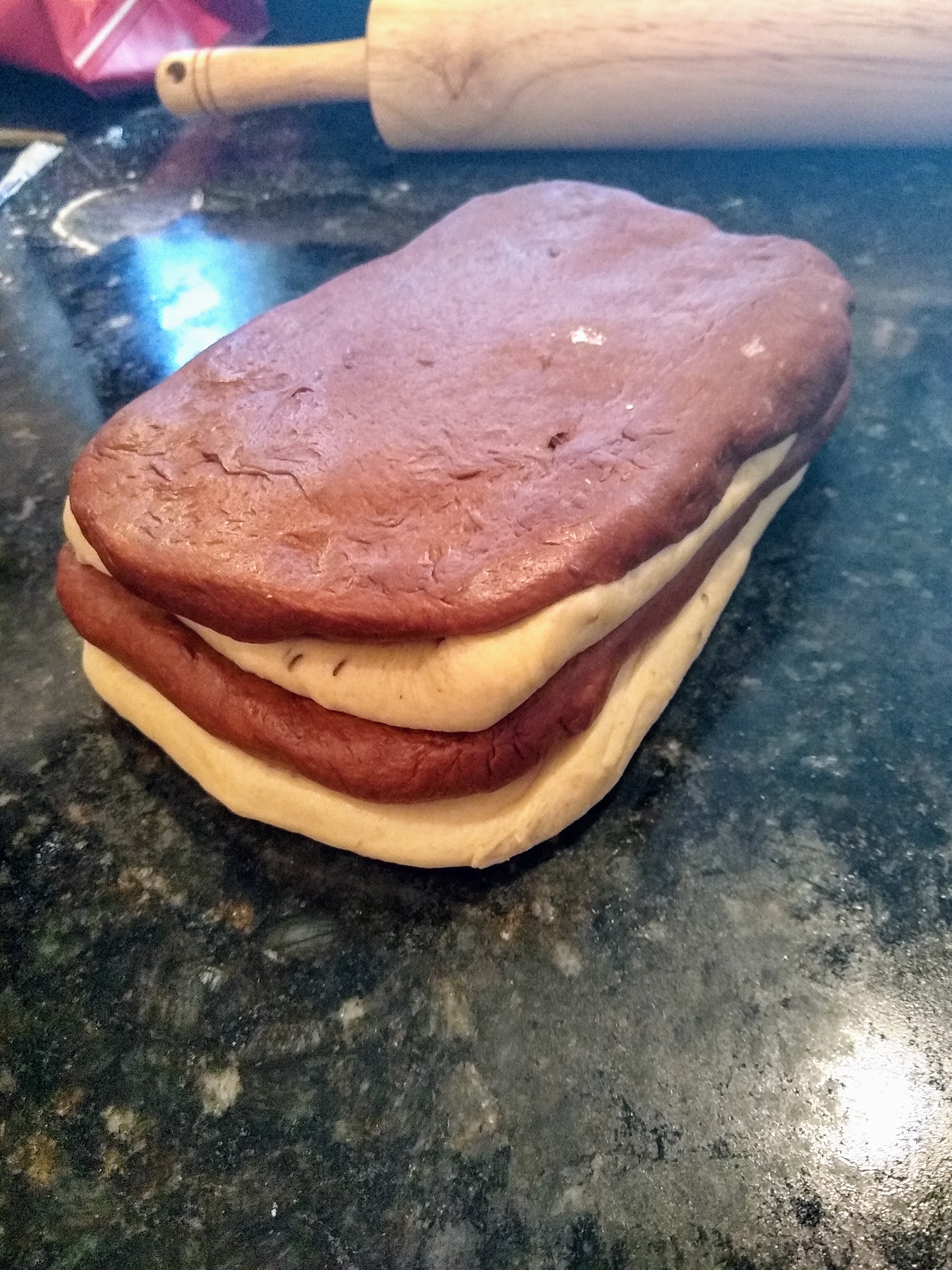

First surprise here was that most of the flour in this recipe was normal bread flour, second surprise was that the only difference between the light and dark doughs was the addition of brown food coloring. I genuinely assumed that they would be made with light and dark flour.
Great taste on this one, makes me want to construct a reuben.
#18: Light Wheat Bread (pp. 189-190)
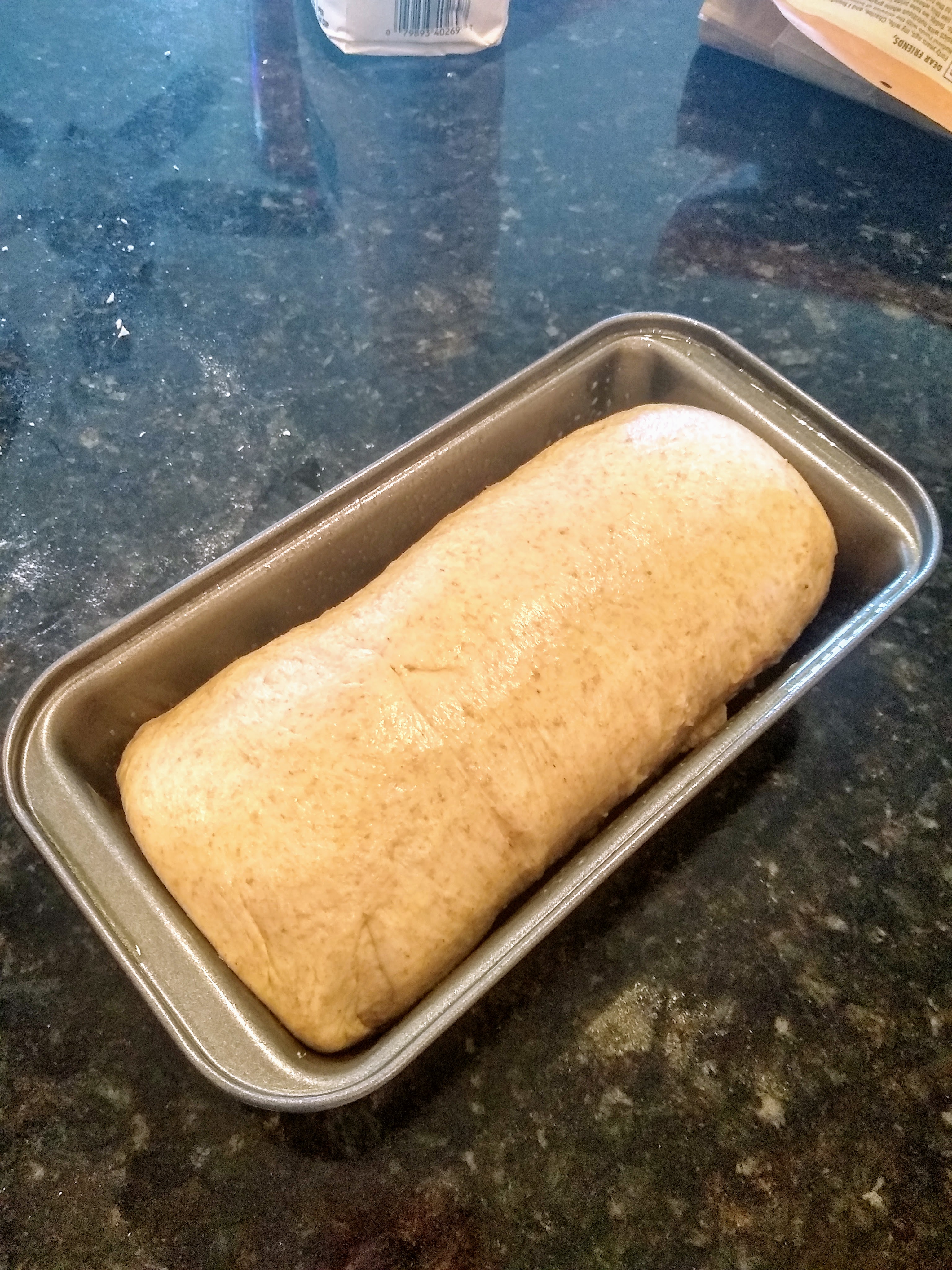

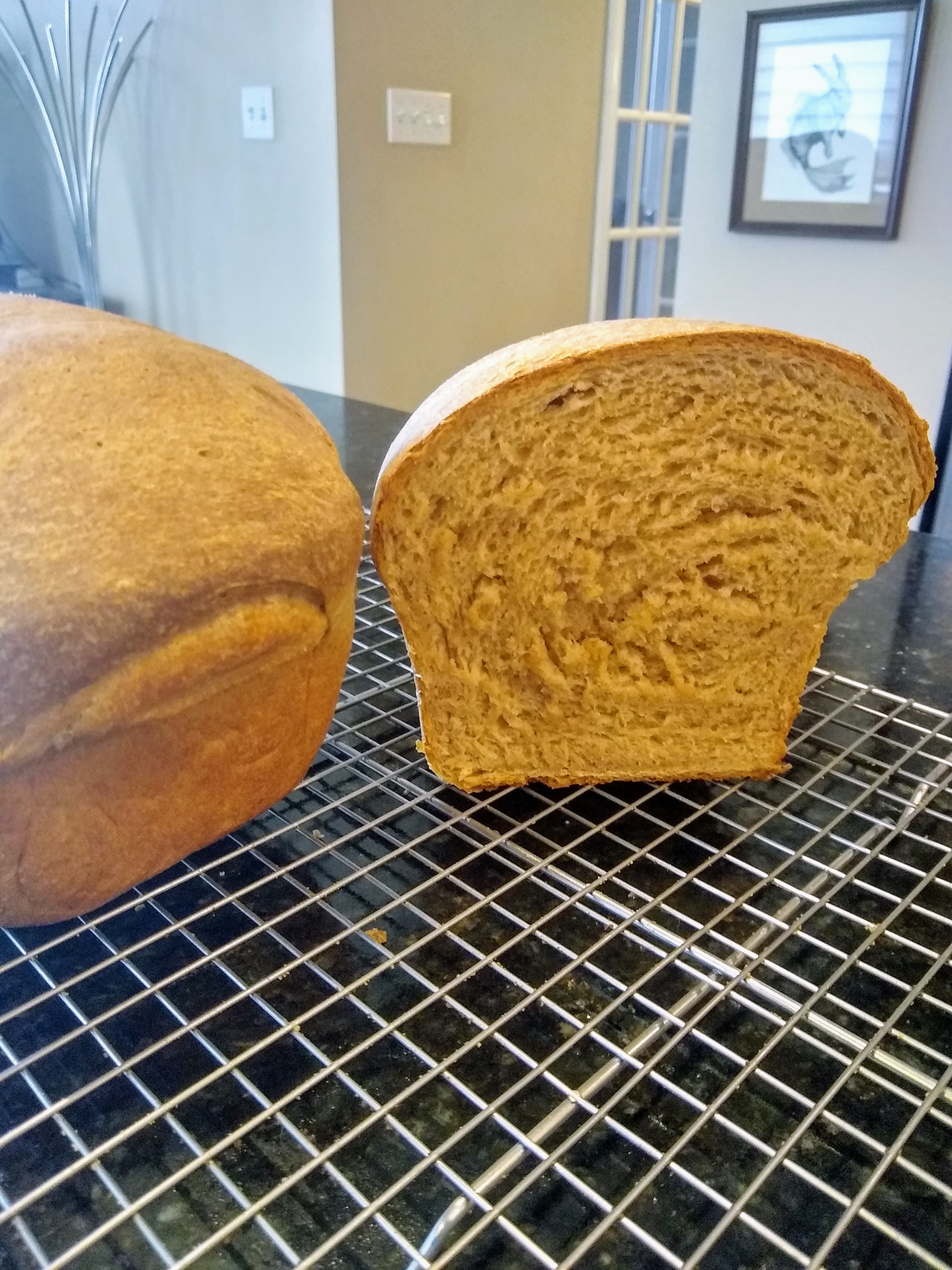
Really fast bread to make, and I was genuinely delighted that it tasted a lot like store bought sandwich bread. Unfortunately, I baked the bread a bit askew in the oven so it’s lop-sided.
#17: Lavash Crackers (pp. 186-188)



Simple, fast and fun. Quick dough, rolled flat, covered in spices and baked. Tasted like those pita chips you can get in bags, and the recipe actually mentioned that this dough could be used for pita bread.
#16: Kaiser Buns (pp. 182-185)

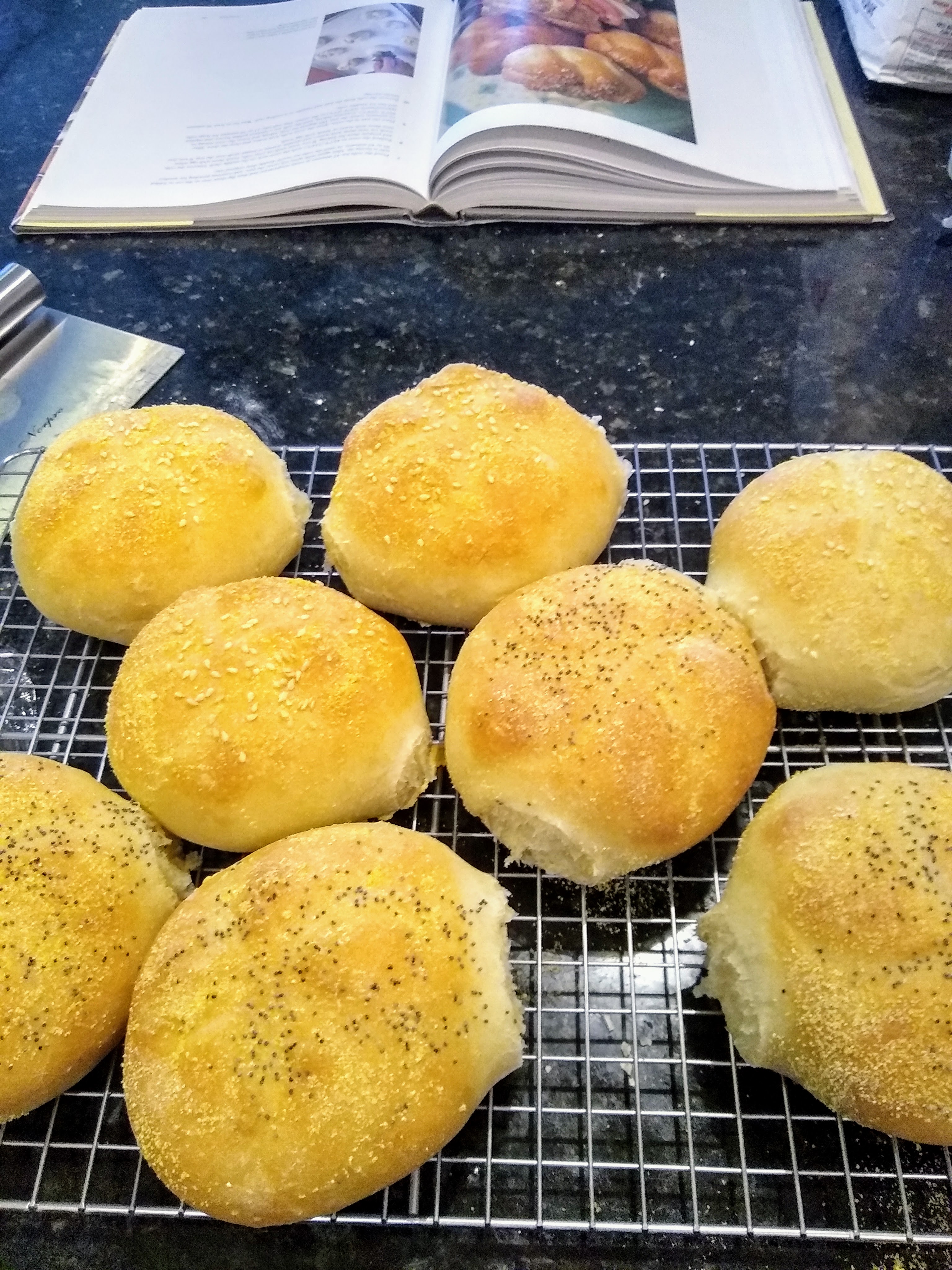
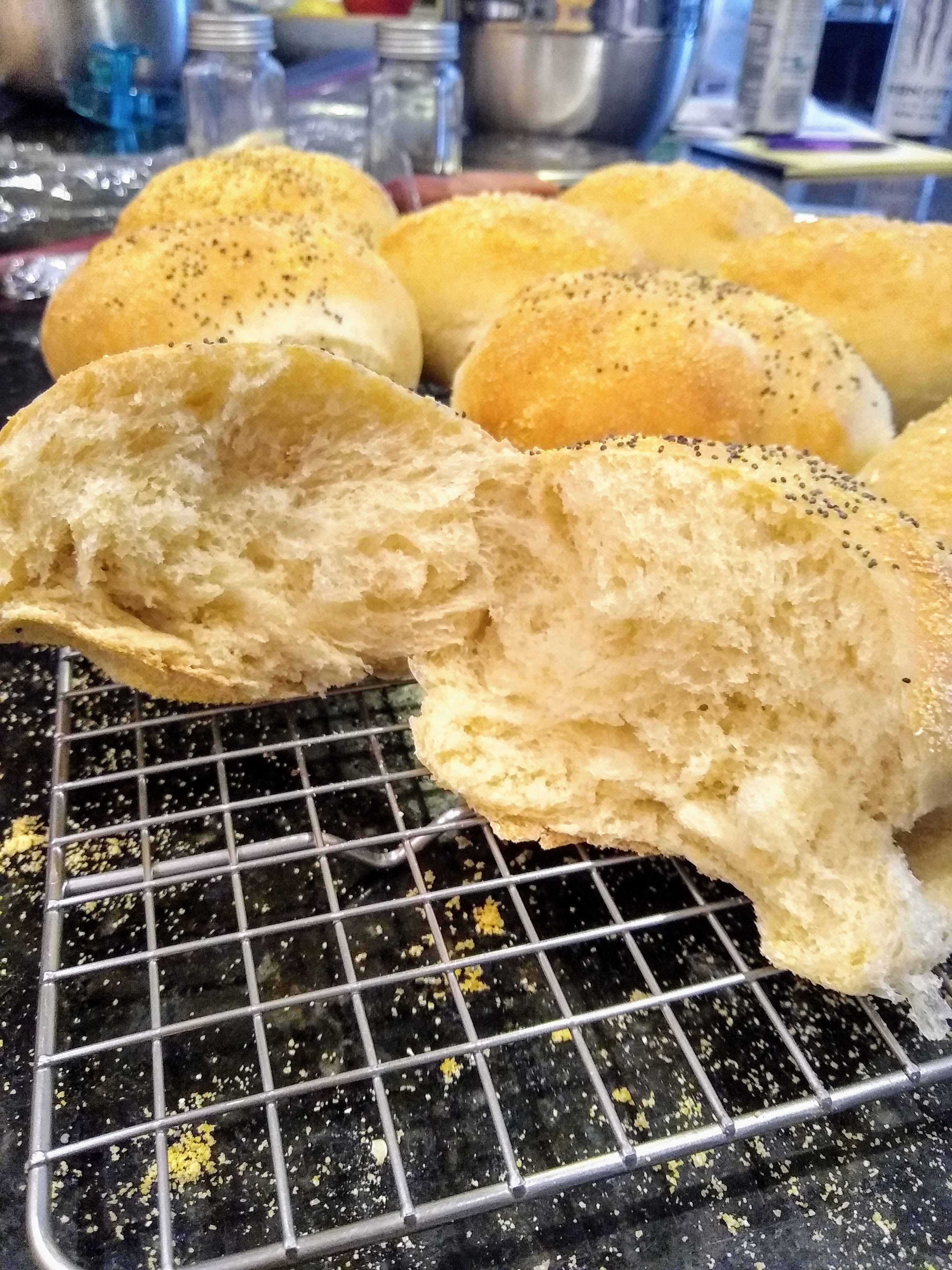
I’ll be honest, despite these being light, airy, tasty bread buns I’m a bit disappointed. I bought a kaiser roll cutter from Amazon specifically so that I could make the characteristic spiral pattern on top of these, and apparently I just didn’t press hard enough for the spiral to stay in (there are the merest hints in the photos). Ah well, another delicious bread!
#15: Italian Bread (pp. 178-181)



Really, really liked this bread. It’s hard to tell from the photos but it was incredibly soft, and the use of the overnight biga gave it a really good flavor.
#14: French Bread (pp. 174-177)



I’m fairly happy with this one. It tastes like French bread. However, I chose to split the dough into 4 baguettes, with I had done three and made them a bit thicker. Rose just fine in the oven after scoring, I did a much better job with managing the steam this time.
#13: Foccacia (pp. 165-173)
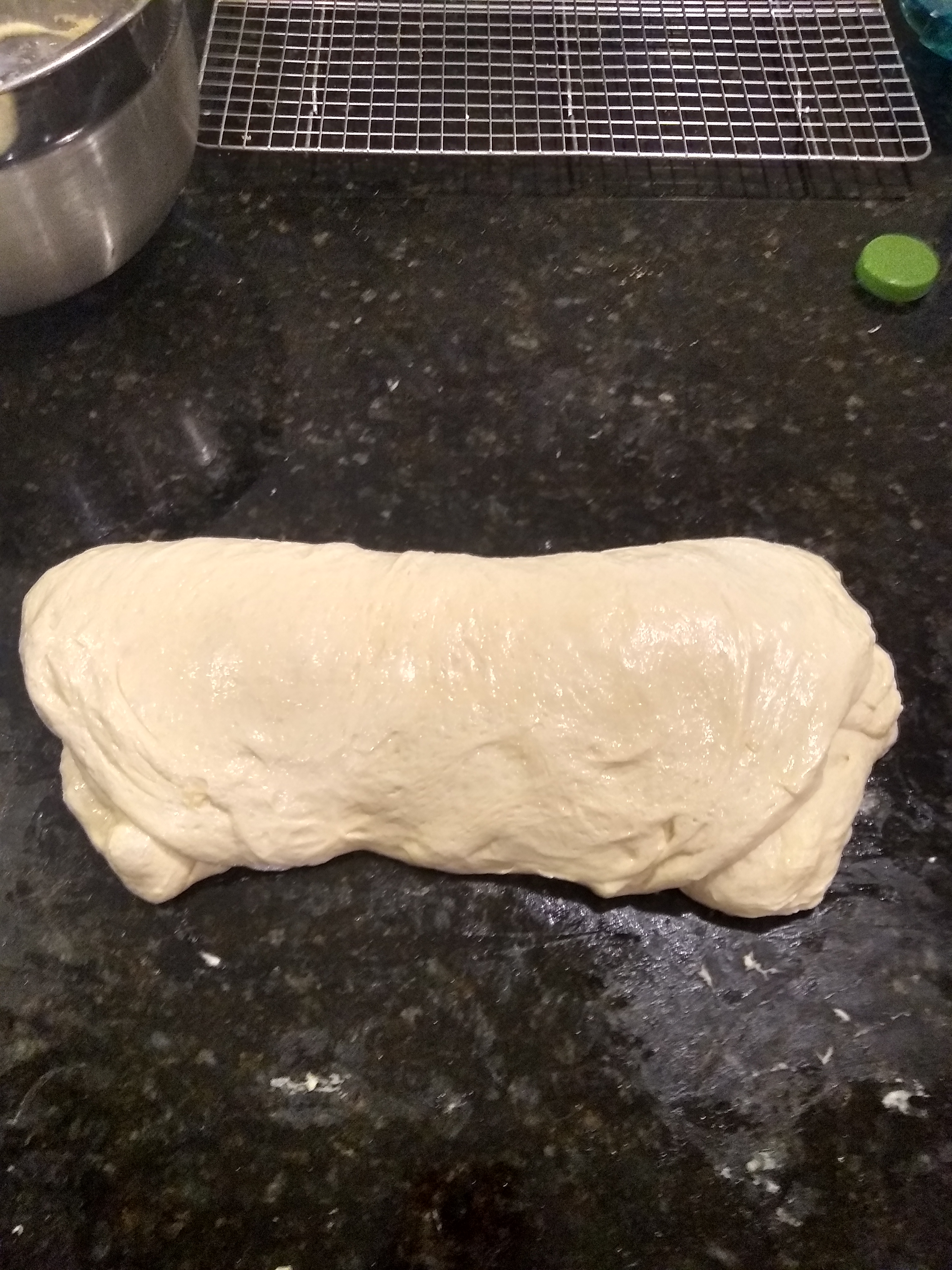


This is the bread that has gotten me the most compliments so far, and it was SO delicious. Very high hydration dough, more oil than I ever expected to use. 100% delicious. Probably my favorite so far.
#12: English Muffins (pp. 163-164)



This may now be the best thing I have ever baked. Perfectly soft in the middle with a bit ofstructure put there by the pan cooked top and bottom. Absolutely delicious!
#11: Cranberry-Walnut Celebration Bread (pp. 160-162)



This one stretched my patience. First time through I got careless and completely neglected to add water, leading to a very stiff dough that just didn’t change size. Second time, I forgot to oil parchment paper, and had to do a careful maneuver where I lifted an uncooked dough braid off the paper it was stuck to. End result tastes good though.
#10: Corn Bread (pp. 156-159)



Another pleasant surprise here, never been the biggest fan of corn bread, but this came out super moist, super tasty and also is incredibly fast to make. This quick bread being in a book that’s otherwise about yested breads is maybe a bit surprising but, still, I enjoyed making it.
#9: Cinnamon Raisin Walnut Bread (pp. 154-155)



This one was the best surprise of the book so far. I went big with the optional additions of cinnamon sugar (with a swirl inside the bread and cinnamon sugar coating) and this was the most delicious bread I have eaten in a long while. 5/5 would make again.
#8: Cinnamon Buns (pp. 150-153)


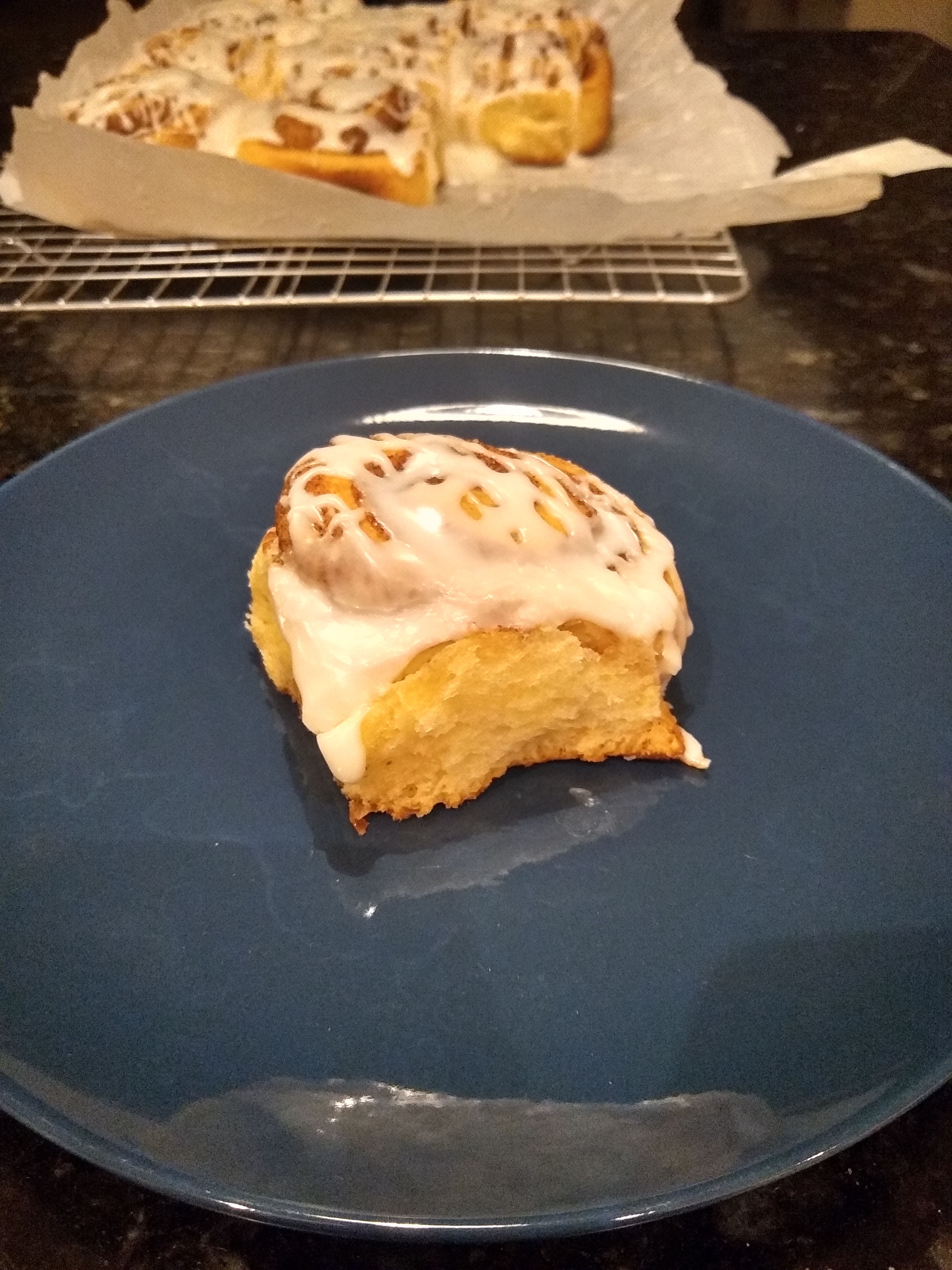
Enjoyed these greatly. For some reason the recipe suggests making the icing drizzle with 4 cups of powdered sugar, which turned out to bee hugely too much, but the buns were absolutely delightful to eat.
#7: Ciabatta (pp. 142-149)



Finally a bake that feels a bit familiar to me, ciabatta is a wet dough with stretch-and-folds, much like the sourdough I learned from the Tartine book.
Overall, everything seemed to go to plan, and the ciabatta that dropped out look nice, golden and rustic. A little disappointing that I didn’t get the airy, bubble-filled crumb I was after (maybe because I wasn’t doing a great job of steaming up the oven, maybe I handled them too violently), but it’s a great tasting bread.
#6: Challah (pp. 140-141)



I was a bit intimidated starting this one. Challah bread is not something I have ever eaten, and I assumed the braiding would be tough to get right. However, after following the instructions, I was delighted when an airy, sweet, pretty looking bread dropped out the other side.
#5: Casatiello (pp. 136-139)



I was very excited to start this. It is after all, cured meat and cheese in a bread loaf. Unfortunately I ended up not liking this one too much. The salami ended up too crispy for my taste, I would have liked more cheese, and the dough is very similar to brioche (very similar recipes, although the casatiello is lighter on the butter). Overall I think I baked it pretty well, just ended up not being to my taste. Meat and cheese in a leaner dough might suit me better and be something I should investigate.
#4: Brioche (pp. 130-135)



I’ll be honest, I didn’t know the first thing about brioche before baking it. I did the “rich-man’s brioche”, which has 88% as much butter as it does flour, which is just insane.
Overall, the dough tasted nice, although I couldn’t stop thinking about the amount of butter in there. Unfortunately, I made a mistake somewhere, and instead of having nice little “heads”, the mini-brioches all fell over. A dough that was too slack, over proofed, or just too much in each container, I’ll never know.
Overall, not a giant fan, but I had fun making it.
#3: Bagels (pp. 121-129)
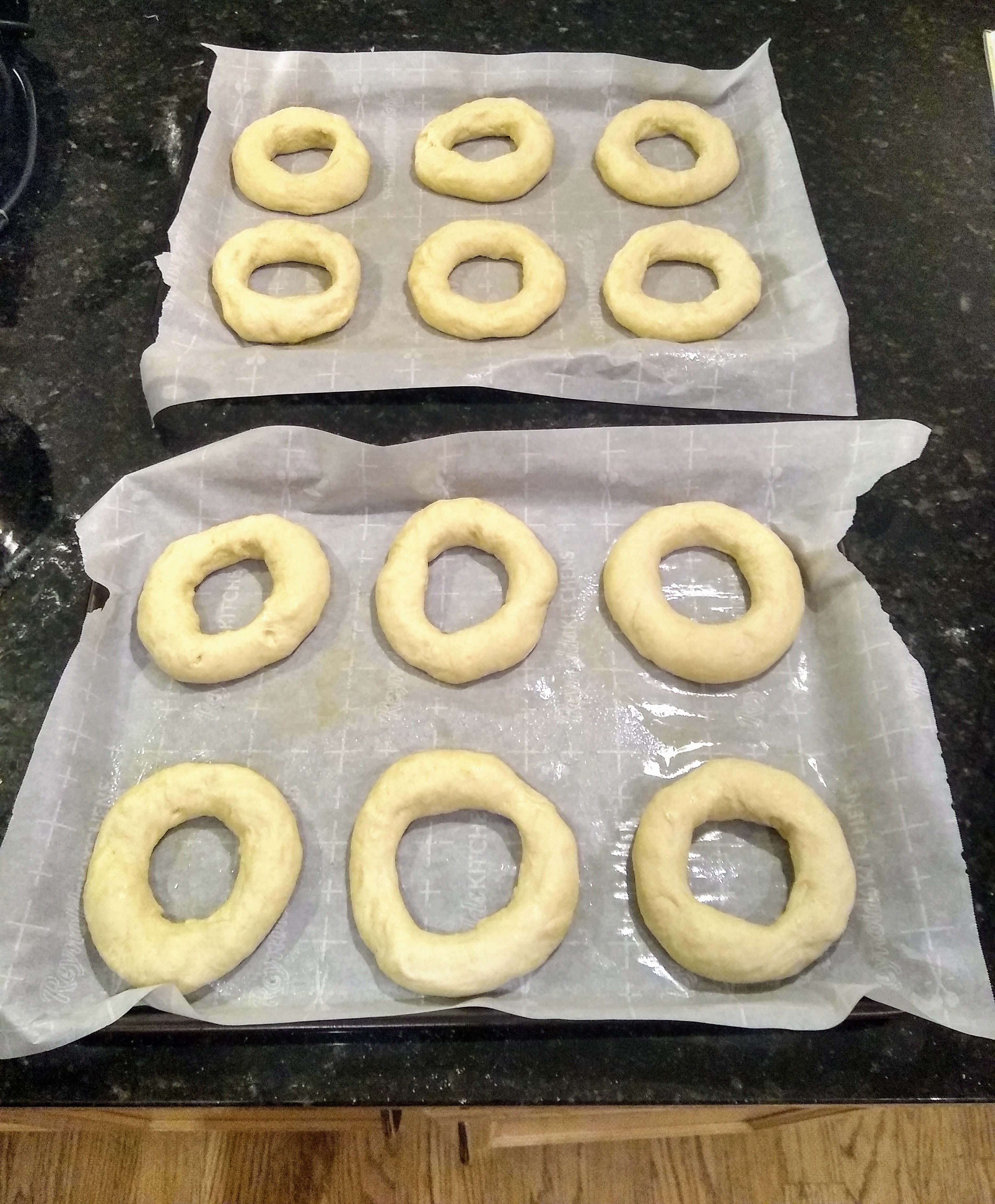


I was pretty excited to try this one, since I love to eat a good bagel, and they have such a different texture from most breads. Very many things in this bake I had never done before, from using high-gluten flour and a low-moisture dough, to boiling each bagel brielfy before baking it.
Overall they came out a little more flat than commercial bagels, but the taste and texture are definitely there. I made bagels!
#2: Artos: Greek Celebration Bread (pp. 117-120)



The second bread in BBA is a traditional Greek celebration bread. Like the first recipe, I didn’t expect to like this one too much (cloves, cinnamon, allspice are not my favorite flavors in general), but this was a delicious bread.
I chose to go with the Christopsomo (Christmas bread), just because the cross decoration didn’t look too hard to do, and the flavors (walnuts, raisins, cherries, orange extract) sounded nice. This was a real blast of Christmassy cheer, and is a bread I could definitely see myself making again for the holidays.
#1: Anadama Bread (pp. 114-116)



Anadama is a traditional bread in New England that contains molasses, milk, and cornmeal (its history is not 100% certain, except it existed in Rockport Massachussetts by 1850). I honestly didn’t expect to like this one too much, since molasses is not a favorite of mine. Overall, though, I was pleasantly surprised that it tasted like a slightly-sweet sandwich bread.
Not my favorite bread in the world, but happy that it worked.